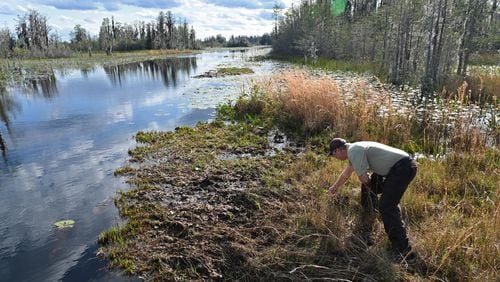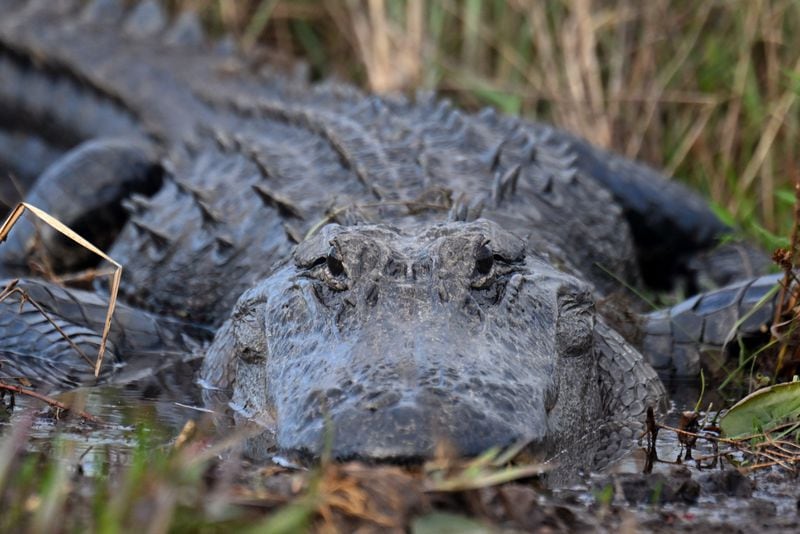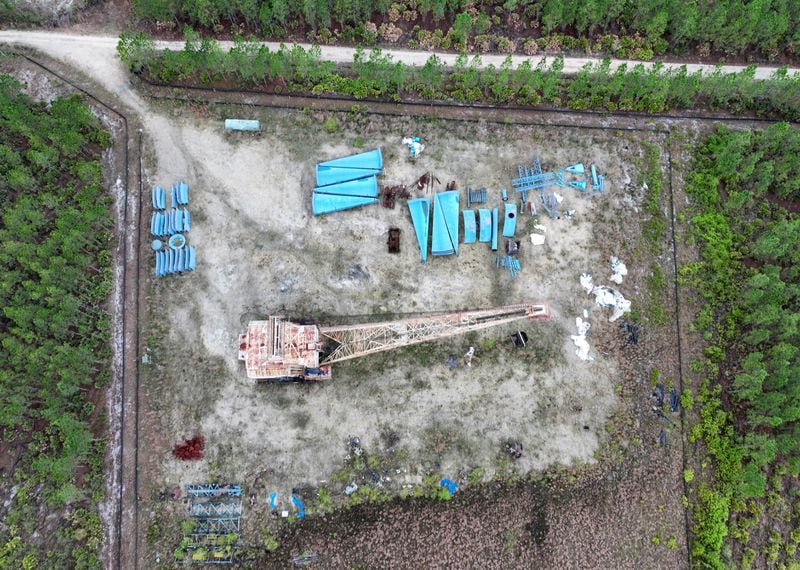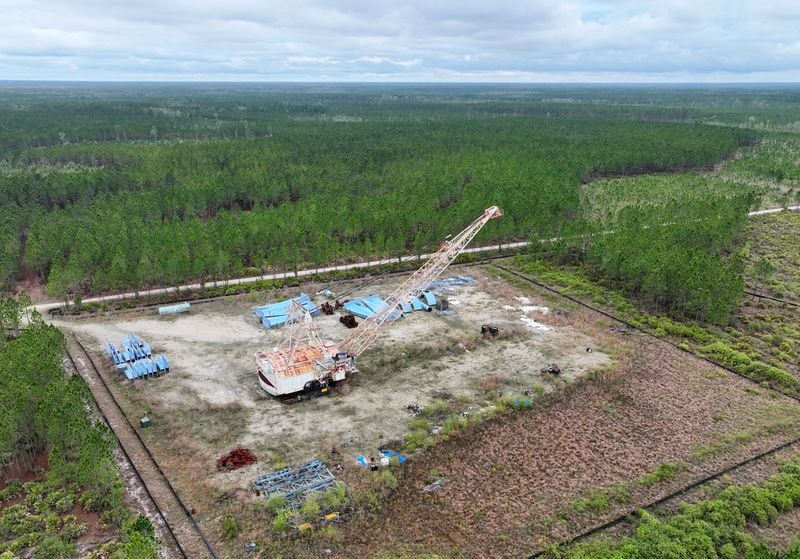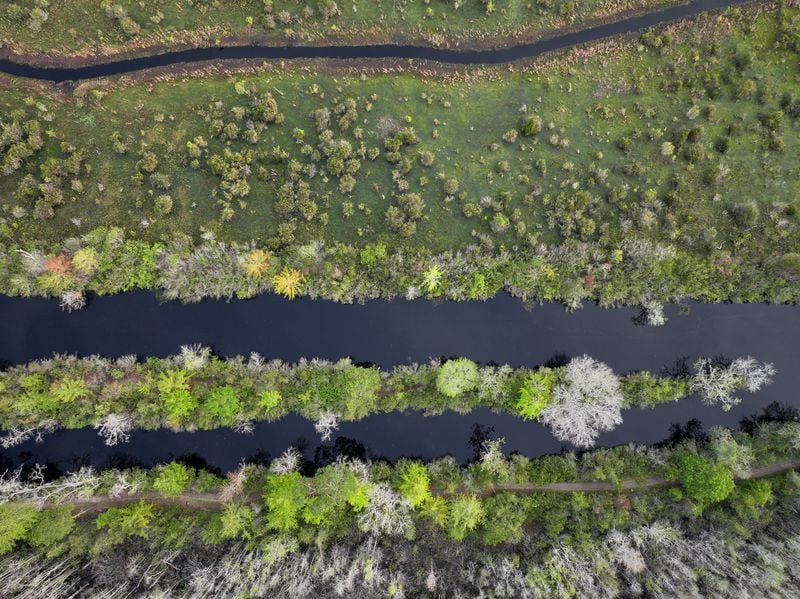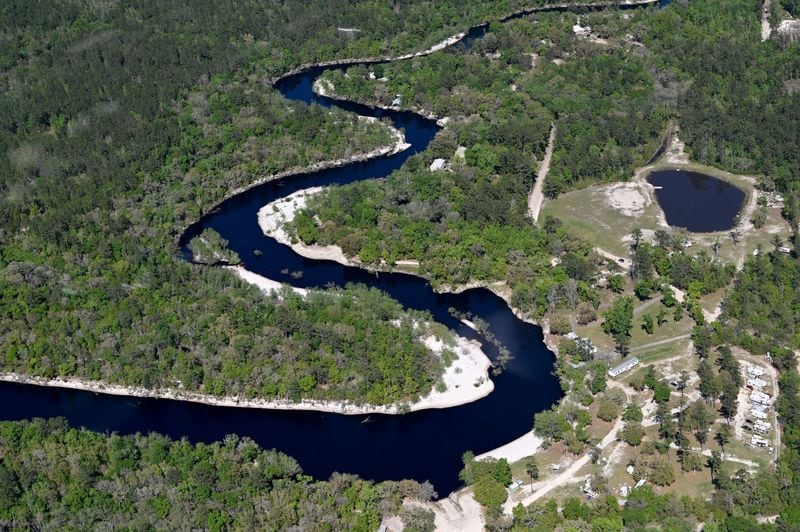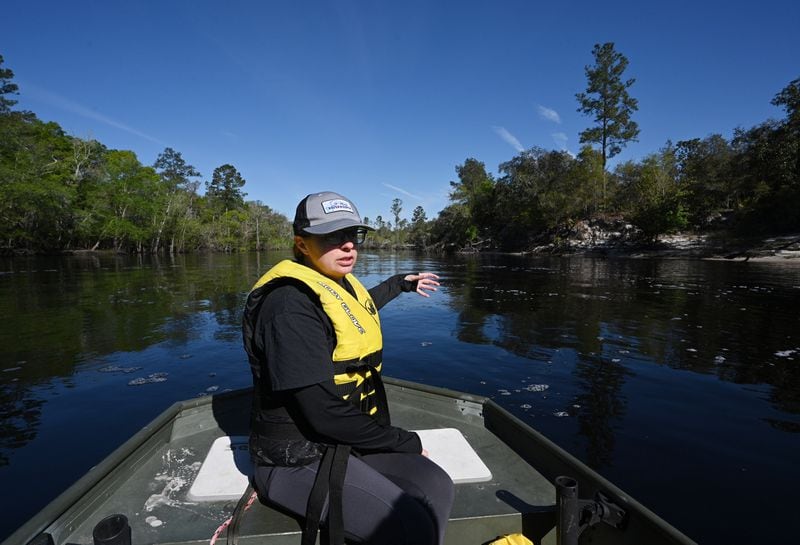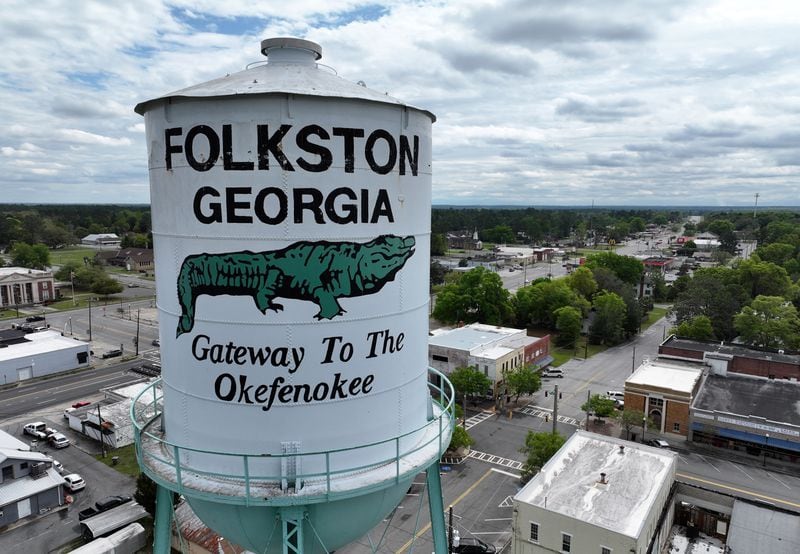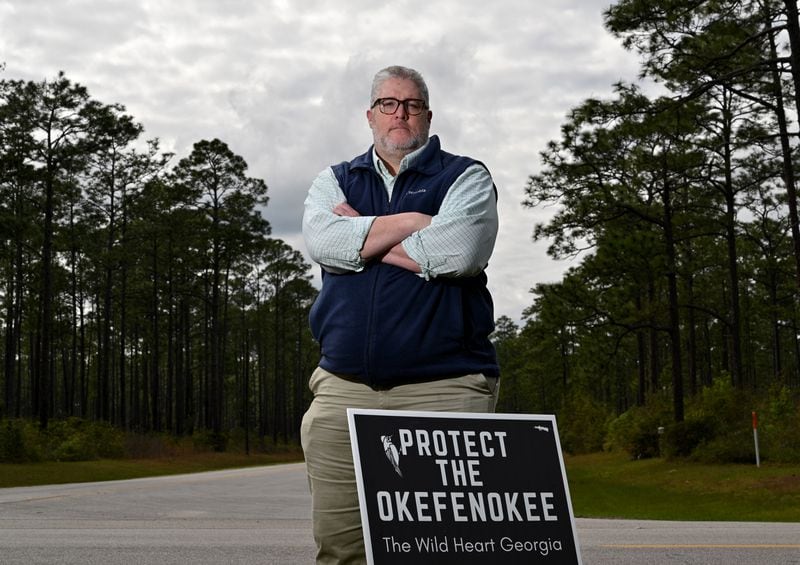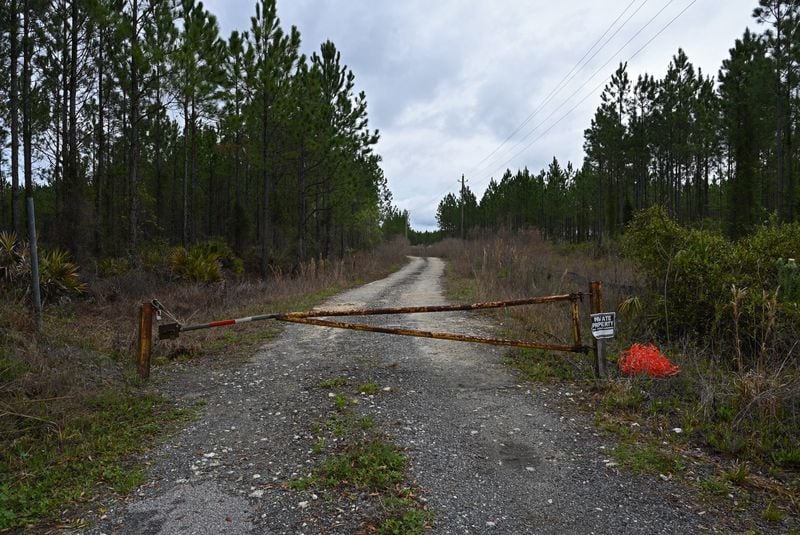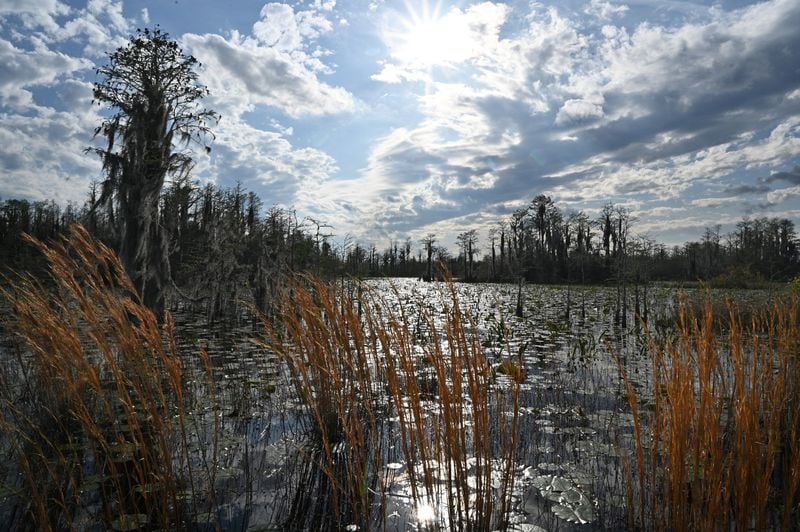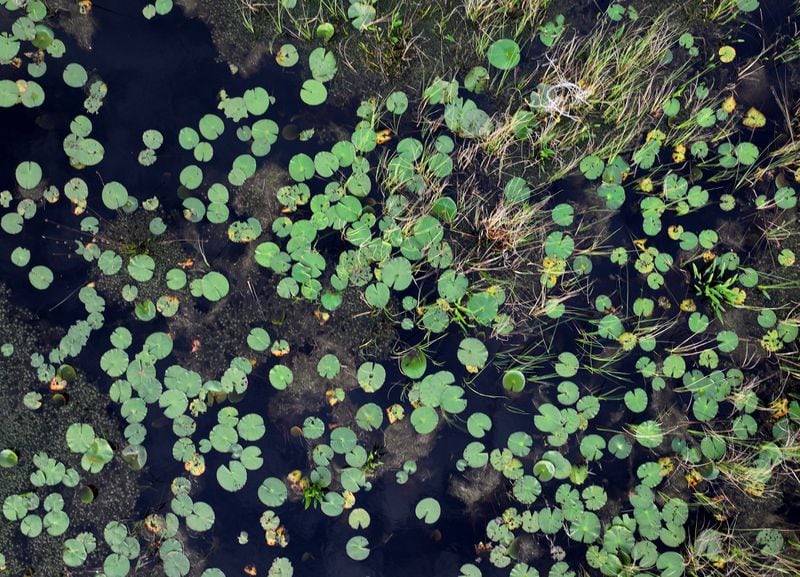FOLKSTON — As the sun peaked through trees draped in Spanish moss on a March afternoon, Michael Lusk steered a boat into the Okefenokee Swamp wilderness.
Across a flooded prairie, great egrets searched for fish among the lily pads and an American alligator sunned itself on a floating bed of peat.
“This is what a wetland is supposed to look like on a massive scale,” said Lusk, who manages the refuge for the U.S. Fish and Wildlife Service (FWS).
Credit: HYOSUB SHIN / AJC
Credit: HYOSUB SHIN / AJC
But a threat looms to one of the world’s largest blackwater wetlands, environmentalists say. For five years, an Alabama company has tried to develop a nearly 600-acre mine on Trail Ridge, the ancient sand dunes that form the eastern boundary of the swamp. Last month, despite opposition from the federal government, the Georgia Environmental Protection Division (EPD) released draft permits for the mine, bringing the project closer to becoming reality.
Proponents of the mine say it could inject jobs and investment into a poor rural county starving for both. The mining company, Twin Pines Minerals, says its analyses show the mine will not lower water levels in the swamp or harm its wildlife. EPD’s own experts have mostly agreed.
But outside scientists, including hydrologists from the University of Georgia and FWS, say the company has failed to prove it won’t harm the ecosystem. Critics contend the mine could wreak ecological devastation and open the door for thousands more acres to be mined.
The fight against the mine is at a critical moment.
The public comment period on the draft permits closes April 9. And with only two days left in the legislative session, odds of a bill passing that would halt Twin Pines’ expansion plans are slim.
Legislation to protect the ridge the company wants to mine has been bottled up in committee, while Twin Pines — aided by about a dozen lobbyists and more than $100,000 in campaign donations since 2018 — has proven savvy in navigating the Gold Dome.
Credit: HYOSUB SHIN / AJC
Credit: HYOSUB SHIN / AJC
One proposal that would temporarily prevent the mine from expanding beyond its current footprint got a boost Thursday when it cleared a key House committee.
Still, some who live near the refuge — along with visitors and environmentalists from around the world — see an existential threat inching closer to a place the Biden administration wants to nominate as a World Heritage Site, joining the ranks of Yellowstone and the Great Barrier Reef.
Lusk says he recognizes the economic draw, but argues they must be weighed against the potential harm to the ecological gem in their backyard.
“The question is what are we risking in order to help an Alabama mining company?” he said.
Federal regulators sidelined
For most of the five-plus decades since the federal Clean Water Act was passed, projects that disturb protected wetlands and other “waters of the United States” have required approval from either the U.S. Army Corps of Engineers or the Environmental Protection Agency (EPA).
Initially, Twin Pines did too.
But through a mix of luck and deft maneuvering, the planned mine has largely avoided the federal government’s gaze.
Credit: HYOSUB SHIN / AJC
Credit: HYOSUB SHIN / AJC
Back in 2020, then-President Donald Trump’s EPA finalized changes that removed protections from many wetlands. That rule was later vacated by two district courts, before safeguards were reinstated by President Joe Biden’s administration.
While weaker Trump-era rules were in effect, the Army Corps determined it did not have jurisdiction over the Twin Pines mine. The Corps tried to reclaim control in 2022, saying it did not consult with the Muscogee (Creek) Nation — a tribe with historical and cultural ties to the swamp — before forfeiting oversight. But Twin Pines sued and a few months later, the parties settled, with the Corps agreeing to stay on the sidelines.
That left vetting of the project in the hands of Georgia EPD.
Though Twin Pines didn’t have a business presence in Georgia before 2019, it’s amassed an army of lobbyists and has made strategic contributions to Gov. Brian Kemp and other key leaders. State filing records show Twin Pines and its president, Steve Ingle, have donated a combined $102,700 to Georgia candidates, elected officials and political action committees since 2018.
A lobbyist for Twin Pines is also married to Trey Kilpatrick, who until recently was Kemp’s chief of staff.
A spokesman for Kemp referred a request for comment on the mine to Georgia EPD and said they do not comment on pending legislation.
Though it has denied wrongdoing, Twin Pines has also been fined $20,000 by EPD for drilling soil samples without a professional geologist on site, or posting the necessary bond to do the work. Both are violations of state law.
Opponents of the mine at the State Capitol have filed one bill, HB 71, that would not block Twin Pines’ current proposal, but would prevent mining expansion on the Okefenokee’s eastern flank. The bill has support from environmentalists and more than 90 House members, but it has been stuck in a House committee without a vote.
Credit: HYOSUB SHIN / AJC
Credit: HYOSUB SHIN / AJC
Critics say Twin Pines’ political donations are behind the impasse.
“Instead of selling out our greatest natural treasure to an Alabama company with an atrocious track record, Gov. Kemp and Speaker Burns ought to follow the science, the law, and the will of the public and protect the Okefenokee now and for future generations,” said Josh Marks, an Atlanta attorney and president of Georgians for the Okefenokee.
Steve Ingle, president of Twin Pines, said its donations were transparent and said attention should be on the mine’s opponents’ spending, who he said are running a “non-fact-based campaign.”
‘Critical shortcomings’
Twin Pines plans to use a bucket controlled by a crane-mounted pulley system to extract titanium sands, a method known as “dragline mining.” Its 500-foot wide by 100-foot long mining pit will move 100 to 200 feet a day across the site, with the company backfilling with sediment as they go.
If finalized, the company’s groundwater permit will allow it to pump nearly 1.5 million gallons a day from the vast Floridan aquifer, which lies beneath south Georgia, Florida and other states. With water and other electromagnetic processes, Twin Pines will separate the titanium-rich minerals it wants from scrap sand. The end product is titanium dioxide, a whitening pigment used in toothpaste, paint and more.
But the mine pit will also impact a shallower aquifer just below the surface. As water seeps into the pit, the company will have to pump water constantly to a series of storage ponds to keep the pit dry.
Without a wastewater permit, the mine will not be allowed to discharge any of it from the site. Instead, it plans to run massive evaporators to send used water into the air as steam.
That pumping and seepage are big concerns to scientists like Rhett Jackson, a professor of hydrology at UGA.
The Okefenokee is known for its black waters, but the swamp is very shallow — just 1 to 3 feet deep in most places — and an estimated 75% of its supply comes from rainfall.
Experts say both factors make the refuge vulnerable to drought and in turn, fire.
Credit: Courtesy of the U.S. Fish and Wildlife Service Fire Management Division
Credit: Courtesy of the U.S. Fish and Wildlife Service Fire Management Division
Fires have always occurred in the Okefenokee and help cycle nutrients through the ecosystem, but several large blazes have torn through the swamp in recent years, often spilling into commercial timberlands.
The largest this century was in 2007 when fire scorched 560,000 acres, including 135,000 acres of privately-owned forest. According to FWS, the fire cost $100 million, not including the estimated $113 million in timber that was lost. Devastating wildfires followed in 2011 and 2017.
Fires in the Okefenokee have global significance, too, allowing vast sums of carbon trapped in the swamp’s peat deposits to burn and sending heat-trapping gases into the atmosphere.
Jackson has analyzed Twin Pines’ plans and estimates they could triple the frequency of drought and wildfires in parts of the swamp near the mine.
“It’s super drought-sensitive and the amount of water they plan to use is going to have a significant effect,” Jackson said.
Credit: HYOSUB SHIN / AJC
Credit: HYOSUB SHIN / AJC
Hydrologists at the National Park Service (NPS) have also identified ‘critical shortcomings’ in Twin Pines’ modeling, arguing the company’s analysis “obfuscates the true impacts from mining on the refuge.”
Twin Pines’ has hired Sorab Panday, a hydrology expert who worked on Georgia’s winning “water wars” case with the state of Florida, to evaluate the mine’s impacts. In a memo last fall, Panday dismissed Jackson’s claims, writing that the mine’s water demands are a “drop in the bucket.” EPD’s own experts say they agree with the company.
“We will take Dr. Panday’s side in a debate with our opponents any day of the week,” Lewis Jones, an attorney representing Twin Pines, said in a statement.
Concerns about the mine’s water impacts extend beyond the Okefenokee, too.
Credit: HYOSUB SHIN / AJC
Credit: HYOSUB SHIN / AJC
The swamp is also the headwaters of two rivers. The Suwannee River forms at its western edge, and the St. Marys River exits the southeastern corner, before winding its way to the Atlantic Ocean.
Like the Okefenokee, the St. Marys is a dynamic ecosystem. After heavy rains, water levels surge and spill into its floodplain. During droughts, the river shrinks dramatically.
EPD says the mine’s water use won’t significantly reduce flows in the St. Marys. But Emily Floore, the executive director of St. Marys Riverkeeper worries the mine will harm wildlife in its black waters, like a distinct population of endangered Atlantic sturgeon found in the river.
“If you’re constantly taking (water), how can you say there’s going to be no impact?” Floore said.
Credit: HYOSUB SHIN / AJC
Credit: HYOSUB SHIN / AJC
‘They’re gonna destroy it’
In Folkston, the Charlton County seat and a town of 4,000 known as the “Gateway to the Okefenokee,” the swamp that lies a few miles west of its Main Street is key to the town’s identity and economy.
Many families have roots going back generations, and the mine is a thorny topic.
Few have deeper ties to the swamp than Sheila Carter. Carter ran guided tours in the Okefenokee for 25 years and her family, the Chessers, settled in the swamp in the 1800s. Today, visitors can explore one of their early homes, on an island that bears the family name.
“God put this here to stay here forever,” Sheila Carter said. “And if they mine, I think they’re gonna destroy it.”
Credit: HYOSUB SHIN / AJC
Credit: HYOSUB SHIN / AJC
Others in Folkston say the town needs jobs.
Charlton County’s median household income is about $46,000, compared to $71,000 statewide. Twin Pines says its project will create 400 jobs with salaries around $60,000.
While leaders in surrounding counties are against Twin Pines, Charlton County’s commission passed a resolution backing the mine in 2019.
Drew Jones, Charlton’s District 4 Commissioner, said he supports the mine — if the experts at EPD determine it’s safe — and doesn’t think the commission’s consensus has changed. The other four commissioners did not respond to requests for comment.
Credit: HYOSUB SHIN / AJC
Credit: HYOSUB SHIN / AJC
The county’s lone hospital closed years ago, its emergency services have been understaffed and the fire department has carried on with outdated equipment. He said those problems only get attention during controversies like this.
“We need help all the time,” Jones said. “We need jobs and we need opportunities.”
There has been mining in the area before, though farther from the Okefenokee’s edge. Decades ago, the Humphreys mine extracted mineral sands on Trail Ridge about seven miles from the refuge.
Glenda Gowen, who was born and raised in Folkston and owns a salon there, said Humphreys brought an economic jolt to the community. She hopes Twin Pines can do the same.
“I felt like it brought in people who build homes, added to the tax base and went to our church,” Gowen said.
Credit: HYOSUB SHIN / AJC
Credit: HYOSUB SHIN / AJC
Josh Howard, a local school administrator and president of the nonprofit Friends of Okefenokee National Wildlife Refuge, is opposed to the mine and said he’s skeptical about the purported job boost. Howard, who oversees the district’s career programs, said the county already shuttles workers in from other communities.
“Yes, it could bring in tax dollars,” Howard said. “But as far as bringing in jobs for locals, I don’t know that we have the workforce.”
‘Willing to take that risk’
Even if Twin Pines obtains final permits, the fight over mining near the swamp may only be beginning.
Records show the company owns nearly 8,000 acres in Charlton County, and it has called the current 582-acre project a “demonstration” mine.
Any expansion would require new permits. But asked whether they intend to mine more land, Ingle, the Twin Pines president, said the company is confident it can show mining is safe on the ancient sand dunes, allowing it seek new permits.
“If our opponents’ claims have merit — if the sky actually falls — those permits will not be granted and our significant investments in land will be wasted,” Ingle said in a statement. “We are willing to take that risk because we trust the science and already know what the demonstration will show.”
Another major landowner nearby has also shown interest in allowing mining on his property.
Credit: HYOSUB SHIN / AJC
Credit: HYOSUB SHIN / AJC
The Toledo Manufacturing Company and its CEO, Joe Hopkins, own tens of thousands of acres of land in the county, including a 30,000-acre tract directly north of Twin Pines’ property. In the 1990s, Hopkins leased a portion to DuPont for a mine that was scuttled after then-Secretary of the Interior Bruce Babbitt opposed the project after outcry from environmental groups.
Last year, Hopkins spoke at a legislative hearing on HB 71, a bill that would prevent mining on his land, arguing it was would infringe on private property rights.
Hopkins also has ties to county leaders. His niece is married to Jones, the commissioner, and Jones is an employee at Toledo.
Hopkins said he has had conversations with Twin Pines and other companies, but no agreements are in place to allow them to mine. Like Jones, Hopkins said a demonstration mine is a responsible way to go.
“Put the equipment out, put the tests down, and if all of a sudden it starts creating a problem three or four miles away, then yeah — shut it down,” he said.
Credit: HYOSUB SHIN / AJC
Credit: HYOSUB SHIN / AJC
Water rights
There is still the specter that the federal government could reinsert itself into the fray.
In January, U.S. FWS’s Acting Regional Director Mike Oetker sent a letter to EPD Director Jeff Cown reserving federal rights to the water that fills the Okefenokee. Oetker wrote the agency is “concerned that the issuance of a permit at this juncture would not preserve sufficient water” for the refuge.
EPD spokeswoman Sara Lips confirmed that Cown and Oetker met on Feb. 12 to discuss the issue and that EPD is evaluating the letter.
Credit: HYOSUB SHIN / AJC
Credit: HYOSUB SHIN / AJC
Robert Glennon, a law professor at the University of Arizona and an expert on water law, said the agency’s argument is more common in the drier, Western U.S.
Glennon said the Okefenokee’s reserved water rights were established when the federal government created the refuge in 1937, but their extent has never been determined — probably because there’s not been a need to. Still, the issue is one the state will likely need to consider, he added.
“Just because they haven’t been quantified, doesn’t mean they don’t exist,” Glennon said.
Editor’s note: This story has been updated to correct the spelling of Trey Kilpatrick’s last name. His wife is listed as a registered lobbyist for Twin Pines.
A note of disclosure
This coverage is supported by a partnership with Green South Foundation and Journalism Funding Partners. You can learn more and support our climate reporting by donating at ajc.com/donate/climate/
